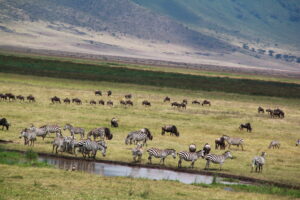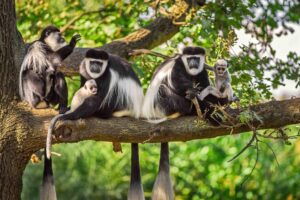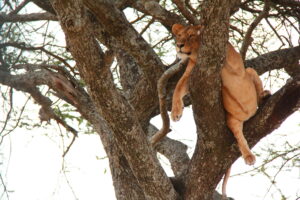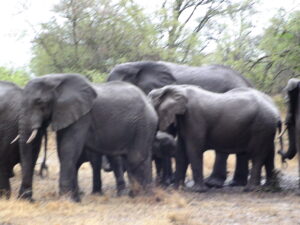Do not hesitage to give us a call. We are an expert team and we are happy to talk to you.
1.8445.3356.33
Help@goodlayers.com
Ngorongoro Crater (Conservation Area)
 |
Your day will seem complete and beautiful if your time in Tanzania will allow you to set your feet in this beautiful Garden of Eden. Why the Garden of Eden? Because long ago the Maasai lived here in peace, living off the land and the wild animals. The land now is conservation, designed to protect the animals. The area is beautiful with a nice view of Lake Makati in the middle of the drive. |
It is a nice game area, which is within a caldera. You can see five of the big animals including elephants, lions, buffaloes, rhinos, leopards, as well as many birds.
We leave early from Arusha, then go on the game drive and finally go back to Arusha. The drive takes 2 to 2:30 hours.
Rates:
Arusha National Park
 |
Take your day in Arusha National Park (Momela National Park). We can offer you a full game drive in this park where there are many animals to see – zebra, buffalo, warthog, giraffe, waterbuck, dik-dik, as well as many flowers and birds around lake Momella. We can also offer you very nice walking within the park so that you can spot animals, like giraffes and buffaloes only a few meters from you. There are also several waterfalls within the park. There is no need for you to worry – you will be provided with a ranger who will make sure most of the time you’re safe from the animals! See a nice view of Mount Meru from this park.
|
Lake Manyara National Park
 |
At this park, there are many animals like elephants, buffaloes, giraffes, zebras, and lions. Many beautiful birds, including flamingos, can be seen around this lake.
|
Tarangire National Park.
 |
Tarangire National park has many wild animals, including many, many elephants, and also buffaloes, zebras, giraffes, as well as birds. After morning breakfast we can drive you to this nice and attractive park and later in the evening we can drive you back to the hotel.
Explore Tanzania’s Indigenous Culture |
Meeting indigenous people and experiencing their rewarding culture, norms, and traditions, while exploring their amazing natural environments, will make your journey unforgettable.
In northern Tanzania, you will find the Maasai and Chagga tribes, a magnificent valley, rivers, lakes, springs, and ridges – all offering a super viewpoint of Mt. Kilimanjaro and Mt. Meru.
Our Cultural Tourism Program Offers:
Rate: $300 per person. This includes transport to the village, food, guide and driver, and the village fee. Tips are appreciated.
Additional option: you can stay the night for $50.
Safe Trekking
Dear friend, please bear in mind there is no such thing as a safe mountain. At Diamond Glacier Adventures we take safety very seriously.
Many people are under the mistaken impression that Africa’s highest mountain is an easy mountain to trek. But without the proper guidance and equipment, it can be a monster.
The biggest enemy on Kilimanjaro is neither weather nor the wildlife but the high altitude. Many people face Altitude Mountain Sickness (AMS), regardless of their fitness level.
What is AMS?
Altitude Mountain Sickness is an illness caused by a reduction of barometric pressure and the concentration of oxygen in the air at a high elevation. Lower pressure makes the air less dense so your body gets fewer oxygen molecules with every breath you take.
There are three levels of AMS – mild, moderate, and severe.
Mild Acute Mountain Sickness
Moderate Acute Mountain Sickness
Severe Acute Mountain Sickness or High Altitude Cerebral Edema (HACE)
Main symptom: the loss of sense and balance
Signs and symptoms – Vomiting, loss of coordination, severe lassitude, seizures, loss of sensation on one side of the body, hallucinations, stupor, confusion, and severe headache.
High Altitude Pulmonary Edema (HAPE)
Main symptom: the accumulation of water in the lungs
This can happen as early as the second night. Usually, it begins within the first two to four days of ascent to higher altitudes.
Signs and symptoms –
Treatments
Altitude sickness
Acetazolamide (Dynamos) is a prescription medication that may help prevent altitude sickness. It works while you sleep; it increases your respiration rate.
Mild altitude sickness
Severe Acute Mountain Sickness or High Altitude Cerebral Edema (HACE)
High Altitude Pulmonary Edema (HAPE)
Hypothermia
Main symptom: an abnormally low body temperature due to a cold environment.
How we lose and conserve heat
This information is summarized from guide training Demi received from Kilimanjaro National Park.
Rates
Hiking the peaks
Climbing Kilimanjaro
Marangu Route (Coca Cola Route)
5 days, 4 nights on the mountain
Machame Route (Whiskey Route)
6 days, 5 nights on the mountain
Rongai Route
6 days, 5 nights on the mountain
Lemosho Route
8 days, 7 nights on the mountain
Umbwe Route
6 days, 5 nights on the mountain
Mt. Meru Trekking
3 days, 2 nights on the mountain
4 Days, 3 nights on the mountain
Extra nights on the mountain are available: $195 per night.
Extra porters are needed to carry extra equipment, such as large camera gear, which costs $10 per day.
Our prices include:
Kilimanjaro International Airport.
